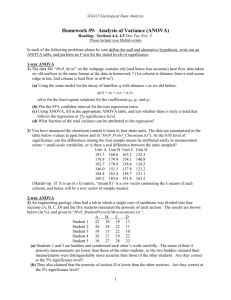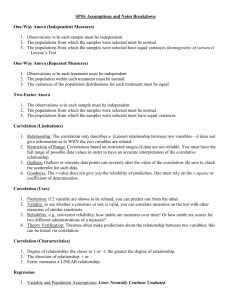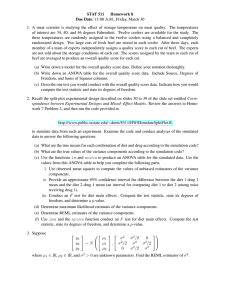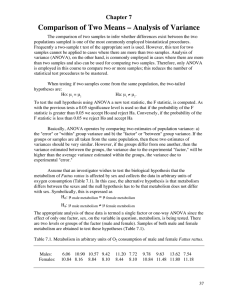slides
advertisement
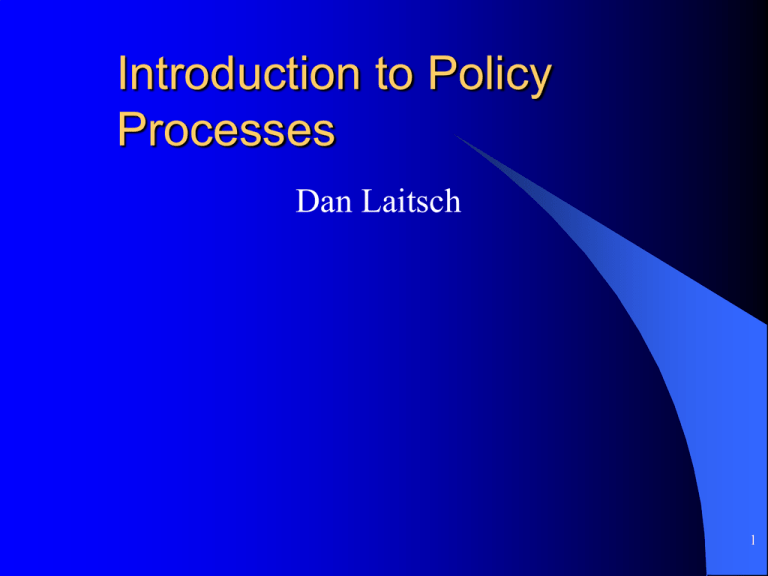
Introduction to Policy Processes Dan Laitsch 1 Overview (Class meeting 5) Sign in Agenda – – – – – – – – – – PBL break out, final project polishing Centre Jobs Review last class Stats PBL planning (presentations) Policy Conclusions [Lunch] Action research Course review Evaluation PBL and dismiss 2 Centre Jobs Program Assistant (CSELP) – Identify, organize, and provide an overview of electronic education policy resources in Canada, including Federal and provincial government resources; think tanks, policy centres, professional organizations, and NGOs; judicial decisions and resources; research resources and data repositories; and news and information sources. Graduate Student Editor (IJEPL) – Assist with review of articles; responsible for article layout and posting. Class : Review – Cohort break outs – Mid term assessment results – Significance and t-tests – Policy and unifying content – Action research 4 Part IV: Significantly Different Using Inferential Statistics Chapter 12 Two Groups Too Many? Try Analysis of Variance (ANOVA) What you learned in Chapter 12 What Analysis of Variance (ANOVA) is and when it is appropriate to use How to compute the F statistic How to interpret the F statistic Analysis of Variance (ANOVA) Used when more than two group means are being tested simultaneously – Group means differ from one another on a particular score / variable Example: DV = GRE Scores & IV = Ethnicity Test statistic = F test – R.A. Fisher, creator Path to Wisdom & Knowledge How do I know if ANOVA is the right test? Different Flavors of ANOVA ANOVA examines the variance between groups and the variances within groups – These variances are compared against each other – Similar to t Test. ANOVA has more than two groups Single factor (or one way) ANOVA – Used to study the effects of 2 or more treatment variables One-way ANOVA for repeated measures – Used when subjects subjected to repeated measures. More Complicated ANOVA Factorial Design – More than one treatment/factor examined Multiple Independent Variables – One Dependent Variable – Example – 3x2 factorial design G e n d e r Number of Hours in Preschool 5 hours 10 hours Male per week per week Female 5 hours per week 10 hours per week 20 hours per week 20 hours per week Computing the F Statistic Rationale…want the within group variance to be small and the between group variance large in order to find significance. Hypotheses Null hypothesis Research hypothesis Omnibus Test F test is an “omnibus test” and only tells you that a difference exist Must conduct follow-up t tests to find out where the difference is… – BUT…Type I error increases with every follow-up test / possible comparison made Glossary Terms to Know Analysis of variance – Simple ANOVA – One-way ANOVA – Factorial design Omnibus test Post Hoc comparisons Part IV: Significantly Different Chapter 14 Cousins or Just Good Friends? Testing Relationships Using the Correlation Coefficient What you will learn in Chapter 14 How to test the significance of the correlation coefficient The interpretation of the correlation coefficient The distinction between significance and meaningfulness (Again!) The Correlation Coefficient Remember…correlations examine the relationship between variables they do not attempt to determine causation – Examine the “strength” of the relationship – Range -1 to +1 – Direct relationships Positive correlations – Indirect relationships Negative correlations Path to Wisdom & Knowledge Computing the Test Statistic Use the Pearson formula So How Do I Interpret… r (27) = .393, p < .05? – r is the test statistic – 27 is the degrees of freedom – .393 is the obtained value – p < .05 is the probability Critical value (Table B4) for r (27) is .3494 Causes and Associations (Again!) Just because two variables are related has no bearing on whether there is a causal relationship. – Example: Quality marriage does not ensure a quality parentchild relationship Two variables may be correlated because they share something in common…but just because there is an “association” does not mean there is “causation.” Significance Versus Meaningfulness (Again, Again!!) Even if a correlation is significant, it doesn’t mean that the amount of variance accounted for is meaningful. – Example Correlation of .393 Squaring .393 shows that the variance accounted for .154 or 15.4% 84.6% remains unexplained!!! “What you see is not always what you get.” Policy (conclusions) Analysis – Frameworks Organize Structure Cannot explain Theories Models Theme: Science, research as a framework Frame-->theory-->model Conclusions Common pool resource theory – Governance from the common pool Agenda setting and policy adoption – Advocacy coalitions – Policy networks Punctuated equalibrium – Incrementalism – Major chance Rationality and the role of the individual – Asimov and Seldon Micro-policy and the role of the institutions Conclusions Strengthening policy theory – – – – – Building logical coherence Seeking causality Empirically falsifiable Defined scope Useful (presents more than obvious outcomes) Developing field (mostly descriptive) – From qualitative to testable Conclusions Next steps – – – – – – – Clarify and specify (ability to be proven wrong) Broad in scope Defines the causal process Develop a coherent model of the individual Resolve internal inconsistencies Develop a research program Respect and use multiple theories when appropriate





